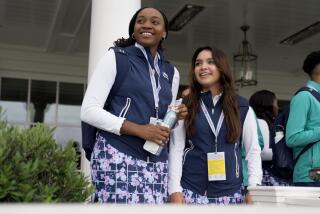It’s <i> Glasnost </i> in Golf for Soviets : Exchange: 10 teen-agers from year-old Moscow club come to Florida for coaching by top pros. Turnabout expected with Americans getting instruction in other sports.
- Share via
NEW YORK — Glasnost has come to golf.
Ten Soviet teen-agers began a tour of the United States Monday that will include two weeks at the PGA School in South Florida for some intensified instruction from pros like Doug Sanders.
How much will it help their game?
“They’ve been playing for one year and their handicap is 18,” said Sven Tumba, who built the first golf course in the Soviet Union. “They learn fast.”
Tumba is the ex-Swedish hockey player who spent a decade selling golf to the Soviets. “Their hockey players would come to Sweden and I would tell them, ‘Why don’t you play golf? This is a beautiful game.’
“Always the answer was ‘Nyet.’ I think they saw it as a capitalist sport.”
Tumba did not give up, though. He kept after Soviet sports authorities and eventually got clearance to construct a course. The first spade of dirt was turned April 24, 1988. “That is the birthday of Soviet golf,” Tumba said. Eighteen months later, last October, the Tumba Golf Club opened for business.
The nine-hole layout sits on what was a downtown dump, a patch of green in the heart of Moscow, about 20 minutes from the Kremlin. It was constructed around a lake--”I used a dog leg, par-5 to go around it,” Tumba said--and plays to a par-34. The last hole’s green sits on an island. There is room on the other side of the lake for another nine holes. It is a start.
Next, Tumba needed players. Corporate memberships for visiting businessmen cost $20,000 but he wanted Soviet players. So he turned to surrounding area schools. Spalding supplied several thousand golf balls and Tumba’s program was under way. “You have to start somewhere,” he said. “We started with the kids.”
About 250 Soviet youngsters took clubs to balls and began learning the basics of the sport, first in school gymnasiums, later on the driving range next to Tumba’s course. The only problem was the balls kept disappearing because the proletariat had never seen these things before and they made dandy souvenirs.
From the first class of players, Tumba and the Soviet sports authorities selected 10 to travel to the United States. There are ambitious plans for future student exchanges--100 Soviet youngsters coming to America to learn golf one summer, 100 Americans traveling to the Soviet Union for instruction in other sports, perhaps hockey or soccer, the following year.
More to Read
Go beyond the scoreboard
Get the latest on L.A.'s teams in the daily Sports Report newsletter.
You may occasionally receive promotional content from the Los Angeles Times.










